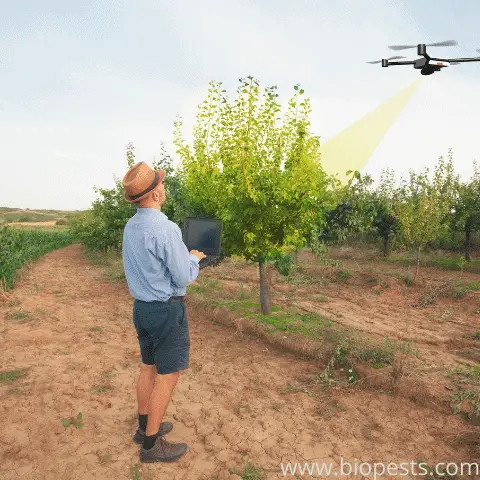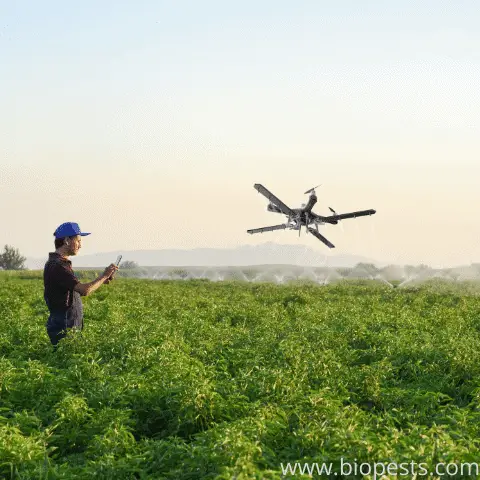Agriculture drones (or spraying drones) are effective at improving the infrastructure and growth of your crops. For drones to be employed, though, the users must follow strict industry standards.
It is legal to fly spraying drones and is approved by the Federal Aviation Administration. While they may not be permitted worldwide, many states support drone usage on farmland. Anyone with a drone license can purchase a spraying drone.
This article will discuss how simple it is to fly a spraying drone. Also, we’ll explain where you can buy spraying drones and outline the different agricultural drone models.
Is It Easy To Fly Spraying Drones?
Flying a drone sprayer is simple once you understand the primary remote control functions of your unique drone. Manufacturers often make drones automatic and add GPS assistance. Despite some advanced features, drone operation is similar to working with a game controller and can be understood by nearly any farmer.
There are several ways that drones can maneuver. Homeland Surveillance and Electronics and Multiplex Drones outlines over three different modes of operation that most drones are suited for:
Mission Planning
Before take-off, farmers must input their desired coordinate into a Ground Station program. This application usually supports highlighting facilities and buildings that you’d like the drone to avoid.
Mission planning is the most common functioning mode of modern farm drones. After confirming your farm’s dimensions, this program requires you to enter the speed, altitude, and area you want sprayed. Typically, that’s all it takes to fly a drone programmed with project planning capabilities.
Afterward, the drone takes flight and does as you requested. So this type of flying requires minimal effort from the farmer.
Remote Control
You can also direct spray drones by hand. Remote control drones are ideal for spot treatment of your crops. Additionally, RC farming drones can be a great time saver when:
- Surveying specific sections of your farm
- Observing multiple angles of your farm
- Exploring unfamiliar terrain

Most drones have a manual mode that gardeners can select to maneuver their flight paths personally. Usually, this mode of operation requires a joystick or buttons. This method is equally as simple as mission planning but requires a hands-on approach.
A-B Mode
The A-B flight mode is suitable for covering smaller farm patches and square-shaped areas. The instructions to control this feature involves:
- Use the remote to fly to a specified corner. Manufacturers recommend that you place the drone at the bottom corner and mark the position as “Point A.”
- Fly to the opposite end. Stick to the same row as your starting point.
- Mark the second point. The drone’s mechanics will consider this “Point B.”
- Move the joystick in the direction you want to fly.
The gadget will automatically spray the field in a zig-zag pattern and will stop on command. Flying in this mode is also simple.
Where Can I Buy Spraying Drones?
The most popular drone manufacturers and suppliers are:
- ARL UAS
- Black Swift Technologies
- C-Astral
- CHC Navigation
- GGS GmbH
- Hitec Unmanned Solutions
- Inspired Flight
- Phase One
- RIEGL
- Skyeton
- T-Drones
- UMS SKELDAR
Agricultural drones are hard to find in retail stores; therefore, farmers often contact the manufacturer directly to buy a drone online. However, if you are near a manufacturer, you can venture there for an in-person shopping experience.
What Do I Need To Purchase a Drone?
Although spraying drones are ideal for farmers, you don’t need a vast farm space to be eligible customers. Spraying drones are appropriate for anyone who:
- Uses pesticides for crop production
- Performs quantity surveillance. This job involves examining large amounts of land to determine necessary materials.
- Evaluates and manages forestry. Drones make it easier to conclude the value of a property accurately.
- Fishes frequently. Agriculture drones help with habitat mapping.

If one of these areas apply to you and you’re interested in investing in a spraying drone to improve the quality of your work, here are the minimum requirements for a manufacturer to sell to you:
Additionally, according to FAA standards, you cannot buy drones on behalf of someone else. It is also illegal to give a spraying drone to someone without the licenses mentioned above.
What To Look for When Buying an Agricultural Drone
Some features will benefit you more than others. These are the things you want to consider before getting this spraying gadget, like:
- Anti-crash software. The drone should be operational despite motor failure to avoid crashing.
- Motor capacity. Discover how many motors the device has and how long they last.
- Anti-collision sensors. GPS sensors decrease the chance of hitting walls, barns, and other obstructions.
- Warranty
- Battery life. Ask how long you can operate the drone before the battery needs to charge/replace.
- Customer support. Is the company available to give you advice after the sale?
- Built-in camera. For maximum efficiency, aim for a drone that gives you visuals of farming grounds.
What Kind of Spraying Drones Are Used in Agriculture?
Agricultural drones come in various styles, and they each come with their own set of advantages and disadvantages. There are two popular drone types:
Rotary Drones
A rotary drone is a scouting tool that consists of propellers much like a helicopter. Rotary drones have several advantages like:
- Hover ability. These drones are easiest to keep stationary over problem areas.
- Simple to maneuver
- Vertical take-off. Rotary drones fly upward at their start; therefore, they can take off and land in tight spaces if necessary.
- Efficiency. Single-rotor drones preserve more energy thus have more robust battery lives.
- Ideal for small fields.
- Multi-rotor options. More rotors on the device make it easier for the user to achieve stability during flight. Also, they have a smoother piloting experience.
And with these come some disadvantages:
- Poor battery life. The average rotary drone can maintain flight for less than 20 minutes.
- Costly. Regarding single-rotor drones, they are usually more expensive than other rotary styles.
- Susceptible to weather conditions. While some rotary drones can withstand strong winds, most models will not function well in harsh weather conditions.
Fixed-Wing Drones
Fixed-wing drones are built similarly to airplanes with two wings extending from the side. These have several benefits not found in rotary drones, including:
- Large-scale spraying. These drones are better at covering vast areas, so they are best for larger farms.
- Long battery life. Fixed-wing devices can stay in flight for 20 minutes or longer.
- Fast. This model can travel at more incredible speeds than propeller drones can.
- Recovery from power failure. A fixed-wing drone can reset after a complete power failure relatively easily.
- Stability. The wings allow this device to withstand windy conditions.
However, there are also some downsides to owning a fixed-wing drone:
- Need landing space. The wings extend widely, so they need a designated landing space, similarly to a plane needing a runway.
- Difficult to understand. These drones aren’t recommended for beginners because they have a challenging learning curve.
- Hard to maneuver. Users have limited access to certain areas.
Vertical Take-Off and Landing (VTOL) Drones
VTOL drones differ from the fixed-wing models and rotary designs in three significant ways:
- The drones have shorter operational flight times. This style has less flight time than fixed-wing drones.
- These models do not require a landing area. VTOL drones land and take off at vertical angles, eliminating the need for landing space.
- Hybrid advantages. Hybrid VTOL drones take off vertically then adjust for horizontal flying once in the air allowing for broader farming applications.
Final Thoughts
Drones are an invaluable farming tool. If you are considering investing in one, your crops will benefit greatly and provide a larger yield with improved grain quality.
Droner Tech has a review discussing the five best drones for agriculture:
All drones are not equal, so it helps to do a great deal of research before making your purchase.

